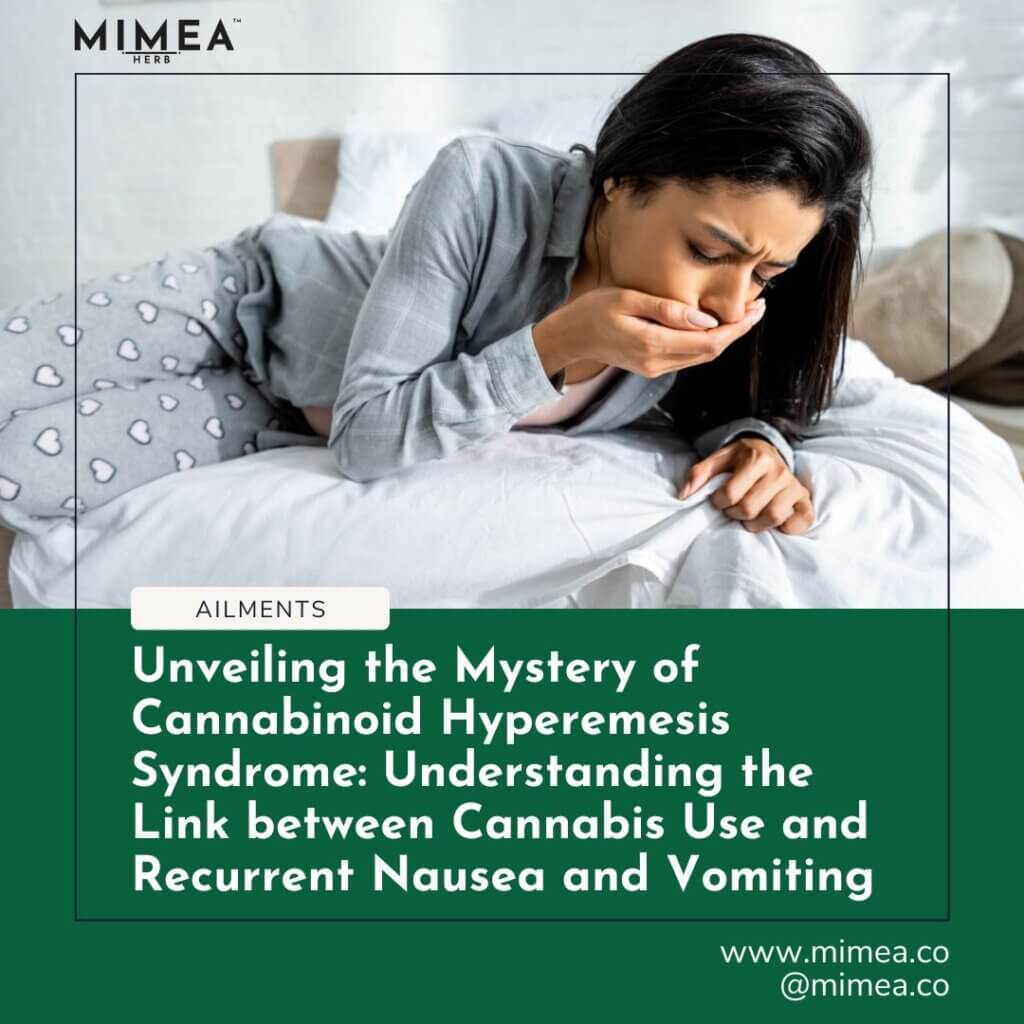Unveiling the Mystery of Cannabinoid Hyperemesis Syndrome: Understanding the Link between Cannabis Use and Recurrent Nausea and Vomiting

Cannabinoid hyperemesis syndrome (CHS) is a condition characterized by recurrent episodes of nausea, vomiting, and abdominal pain that are associated with long-term heavy cannabis use. The symptoms of CHS typically improve with abstinence from cannabis use.
The exact prevalence of CHS is not known, but it is believed to be relatively rare. However, as the use of cannabis becomes more prevalent and accepted, the number of cases of CHS may increase. Studies have shown that CHS is most commonly found in young adults and in areas where cannabis use is legal or decriminalized. The prevalence of CHS is also found to be higher in males than females.
Causes of Cannabinoid Hyperemesis Syndrome
Role of cannabinoids (THC, CBD) in the development of CHS
The main active ingredient in cannabis, tetrahydrocannabinol (THC), is believed to be the main cause of CHS. THC is thought to activate specific receptors in the brain, called CB1 receptors, which are involved in regulating nausea and vomiting.
High levels of THC in the body can overstimulate these receptors, leading to the development of CHS. Some studies also suggest that high levels of CBD, another cannabinoid, may also be associated with the development of CHS. However, more research is needed to fully understand the role of CBD in CHS.
Possible genetic and environmental factors that may increase the risk of CHS
While the exact causes of CHS are not fully understood, there may be certain genetic and environmental factors that increase an individual’s risk of developing the condition. For example, some studies suggest that individuals with a certain genetic variation in the CB1 receptor may be more susceptible to developing CHS. Additionally, environmental factors such as stress and poor nutrition may also increase the risk of CHS.
It is important to note that more research is needed to fully understand the underlying causes of CHS and to identify potential risk factors.
Symptoms of Cannabinoid Hyperemesis Syndrome

Recurrent episodes of nausea and vomiting
The most common symptom of CHS is recurrent episodes of nausea and vomiting, which can be severe and prolonged. These episodes can occur several times a day and can last for several days to weeks.
Abdominal pain
Many individuals with CHS also experience abdominal pain, which can be cramping or a dull ache. This pain can be severe and can be located in different areas of the abdomen.
Compulsive hot water bathing
Another unique symptom of CHS is compulsive hot water bathing. This refers to the repetitive and frequent use of hot water for bathing or showering, with the belief that it will provide relief from the symptoms of CHS.
Relief of symptoms after cessation of cannabis use
CHS is typically associated with long-term heavy cannabis use, and the symptoms of CHS typically improve with abstinence from cannabis use. This is one of the key characteristics that help to differentiate CHS from other conditions that present with similar symptoms.
It is important to note that the symptoms of CHS can vary from person to person and may not always be present in all individuals with the condition.
Diagnosis of Cannabinoid Hyperemesis Syndrome

Clinical criteria for diagnosis
CHS is typically diagnosed based on a combination of clinical criteria and a history of heavy cannabis use. The clinical criteria for CHS include recurrent episodes of nausea and vomiting, abdominal pain, and compulsive hot water bathing.
Additionally, the symptoms of CHS typically improve with abstinence from cannabis use.
Differential diagnosis with other conditions that present with similar symptoms
CHS can be difficult to diagnose as the symptoms can resemble those of other conditions such as cyclic vomiting syndrome, functional gastrointestinal disorders, or even other substance use disorders.
A thorough medical history and physical examination, along with laboratory and imaging studies, can help to exclude other potential causes of the symptoms.
Lack of definitive diagnostic tests for CHS
Currently, there are no specific diagnostic tests for CHS. The diagnosis of CHS is typically based on the individual’s symptoms, medical history, and physical examination.
It is important to note that CHS is a relatively rare and underdiagnosed condition, and many cases may go unrecognized. As such, healthcare providers should consider CHS in individuals with a history of heavy cannabis use and recurrent episodes of nausea, vomiting, and abdominal pain.
Treatment of Cannabinoid Hyperemesis Syndrome
Abstinence from cannabis use
The most effective treatment for CHS is abstinence from cannabis use. Once the individual stops using cannabis, the symptoms of CHS typically improve within a few days to a few weeks. However, some people may require time to stop using cannabis, support groups, or even rehabilitation.
Supportive care for symptoms such as nausea and vomiting
Supportive care is also important in the management of CHS. This can include measures to alleviate symptoms such as nausea and vomiting, such as the use of antiemetics or medications that help to reduce nausea.
Symptomatic treatment for compulsive hot water bathing
Individuals with CHS may also require treatment for compulsive hot water bathing, which can include cognitive-behavioral therapy or medications to reduce the urge to bathe excessively.
It is important to note that, as CHS is a relatively rare and underdiagnosed condition, there is limited research on the most effective treatments for the condition. Therefore, treatment options may vary, and healthcare providers may need to individualize treatment based on the specific needs and circumstances of each patient.
Conclusion
Cannabinoid hyperemesis syndrome (CHS) is a relatively unknown and under-diagnosed condition that is caused by long-term heavy cannabis use. It is characterized by recurrent episodes of nausea, vomiting, and abdominal pain, along with compulsive hot water bathing. The symptoms of CHS typically improve with abstinence from cannabis use, and supportive care and symptomatic treatment may also be necessary.
As the use of cannabis becomes more widely accepted, it is important for healthcare providers to be aware of CHS and to consider it in individuals with a history of heavy cannabis use and recurrent episodes of nausea, vomiting, and abdominal pain. Early recognition and management of CHS can prevent unnecessary suffering for affected individuals and reduce the burden on healthcare systems.
Additionally, it is crucial to further research the condition to understand the underlying causes and to develop more effective treatments. As well as to raise awareness among the public and healthcare providers about the existence of CHS, in order to reduce the number of undiagnosed cases and to ensure that individuals are receiving appropriate care.
Explore the benefits of cannabis, herbs, adaptogens, and more to improve your daily life. Connect with other members, attend exclusive classes, and more by downloading our app at www.mimea.co/app.






Responses